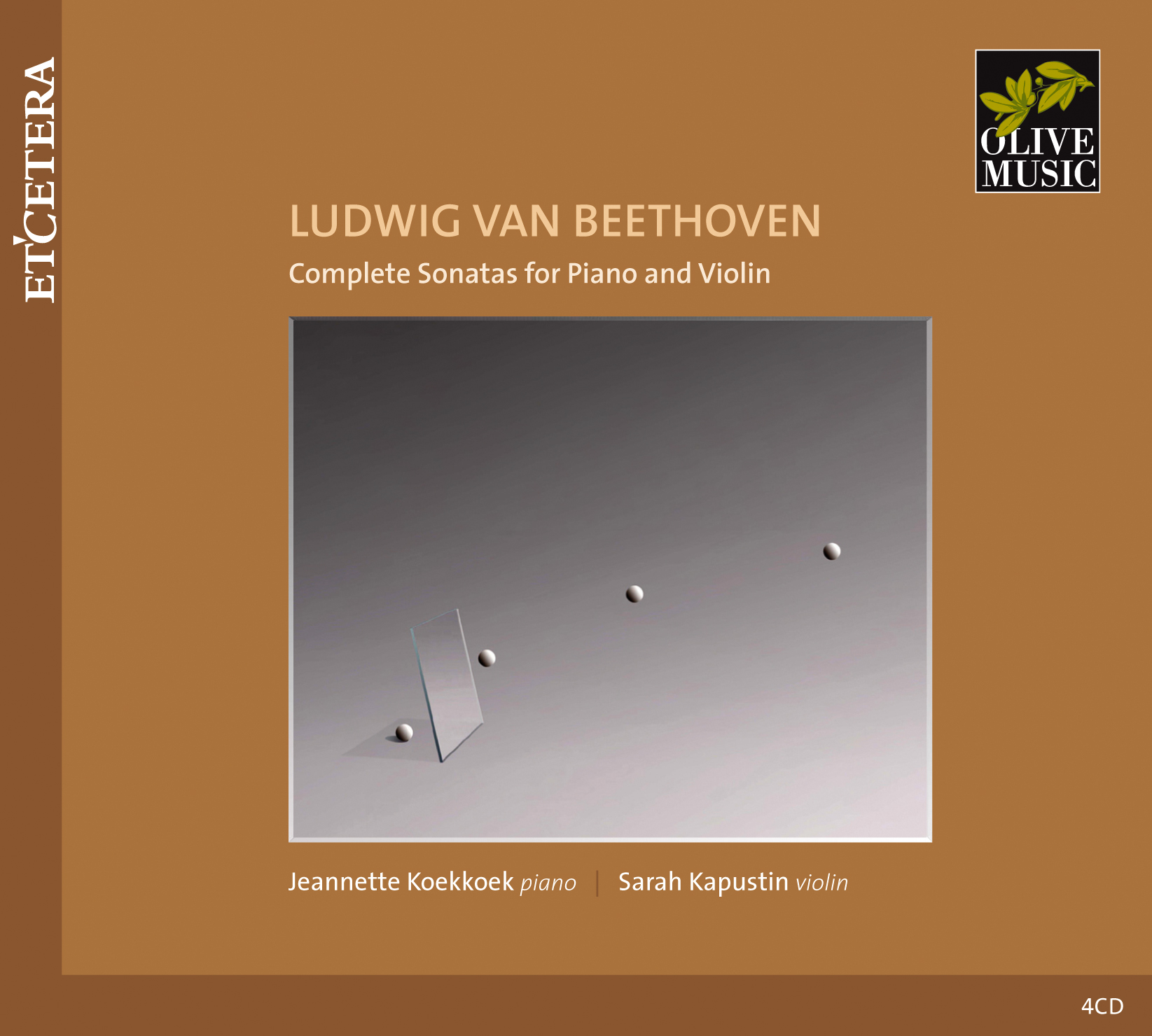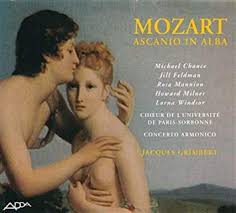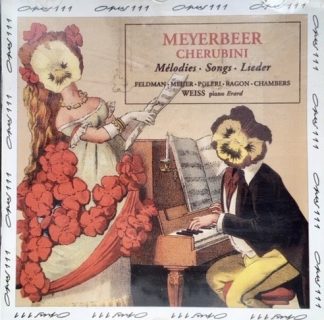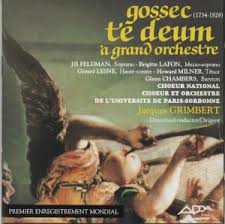Description
BEETHOVEN 10 Violin Sonatas • Sarah Kapustin (vn); Jeannette Koekkoek (pn) • ET’CETERA 1904 (4 CDs: 241:48)
The notes to Sarah Kapustin and Jeannette Koekkoek’s recordings of all 10 of Beethoven’s violin sonatas cite a number of earlier violinists and teachers who considered the works neither central in the composer’s output nor particularly recommendable to students or performers. Now things have changed, and many complete sets have become available, of which Kapustin and Koekkoek’s constitute a recent addition. Their engineers have balanced the instruments (they emerge as relative equals) and created for them, in the Studio Valter Neri, Montevarchi, Italy, an ambiance that’s neither over-reverberant nor over-dry: like the middle bowl of porridge, just right.
In the First Sonata’s opening movement, the instrumentalists demonstrate what seems to be their relationship (a close, collaborative, one) and their composite musical personality—strong without being explosive, and subtle without being fussy. Their adherence to the score’s markings, for example, seems faithful without being slavish; sudden changes in dynamics never sound intimidatingly aggressive (a trait that can grow tiresome, as many may find them in Alina Ibragimova’s celebrated recent set). Subtleties abound, but they never impede the music’s steady forward motion. They play the second movement’s theme with genial relaxation, though they unleash the tonal power they’ve held in reserve in the second variation. The finale sounds commanding but lively. Kapustin draws from her violin a generally strong tone that tends a bit toward heaviness and seldom seems lush; yet it isn’t steely, either, and possesses enough cushion to lie comfortably on the listener’s ear over the course of a long work. (And, going through the entire set, this can be a great benefit—as well as a relief.)
The Second Sonata leads the two instruments together for several measures in 16th notes, and Kapustin and Koekkoek exhibit in these near-perfect ensemble. They’re equally adept at delineating moods, as in the mystery they reveal in the closing theme at the first section’s end. Koekkoek plays with a sharpness and bright energy that reflect similar qualities in Kapustin’s way with the violin part. The intimacy of their dialogue lends consistent interest to the second movement; while they don’t overemphasize any quirkiness in the finale’s thematic material and development, they certainly communicate its playfulness.
In the Third Sonata, their ensemble in the measure in which the instruments sprint side-by-side sounds nearly perfect, and both Koekkoek and Kapustin reach a higher level of intensity in meeting the expressive demands that the movement imposes for ever-stormier outbursts. Captious listeners might suggest that Kapustin’s accompanying at the beginning of the slow movement and soon thereafter seems too aggressive, but Koekkoek’s expressive detail never gets buried alive under it (in her turn to accompany the violin’s cantabile in 32nd-note patterns, she’s much more discreet, though the score indicates that both parts at the outset be taken piano). They play the impertinent secondary idea in the finale without exaggerating the impudence that sometimes makes it sound less closely related to the first theme.
The set divides the sonatas into logical historical groupings; after the first three of the first CD, dedicated to Antonio Salieri, come the two on the second CD, both of them dedicated to Count Moritz von Fries. The greater subjective element mentioned by Evan Rothstein in his booklet notes emerges from the very beginning of the Fourth Sonata, and the duo adjusts to this difference in outlook not abruptly but by allowing the dynamic elements already inherent in their performances of the first three sonatas to assume greater importance. Their contrasts in the first movement, accordingly, become more sudden and more pronounced. Their rhetorical flair in the fugato-like contrapuntal outburst near the beginning and end sounds appropriate to the movement’s hybrid nature. In the finale, they set down comfortably with the more settled yet almost ominous stepwise thematic material, reconciling it with the considerable energy that the composer has generated from it. Rothstein likens the Fifth, or “Spring,” Sonata to the Sixth Symphony, and this “pastoral” landscape also experiences its share of storms, though they’re not concentrated in a single movement; Kapustin and Koekkoek recognize them as they appear on the horizon. Extending the comparison, could the slow movement be taken as corresponding with the symphony’s scene by the brook? In any case, at times Kapustin occasionally seems to intrude her figuration more forcefully than the dynamic markings suggest, without, however, disturbing the movement’s generally even keel. Joseph Szigeti and Claudio Arrau played the rhythmically tricky Scherzo and especially the Trio with the energy of an exploding supernova. If Kapustin and Koekkoek don’t reach that level of dynamism, it would seem that they don’t intend to, for surely they’re tonally, emotionally, and technically capable of it. They allow menacing clouds to darken the Rondo’s episodes, sunny and clear though they may make its main theme appear.
The third disc brings the three sonatas dedicated to Tsar Alexander. The Sixth might seem to be the most problematic of the entire set and the most difficult for violinists to embrace musically (Beethoven saved its original finale for the “Kreutzer”). As in their performance of even the First Sonata, Kapustin and Koekkoek don’t exaggerate nuances, while they endow the first movement’s expressive devices with enough detail to hold the attention even of a listener well acquainted with the work. Kapustin enhances the second movement’s lyricism with an especially warm tone in the lower registers. The composer based the Allegretto con Variazioni that became the finale on a leisurely theme, but in the first variation and the third, one that trades motives in stretto-like imitation, the duo bristles with energy and they allow the mood to darken temporarily for the Fifth, Minore. The Seventh Sonata may represent a leap beyond the expressivity of the First, but following the duo step-by-step through the works makes the transition seem smoothly natural. Accordingly, Kapustin and Koekkoek’s stormy reading of the first movement emerges as a development of their serious approach to even the most lighthearted moments of the earliest sonata (just as their flowing lyricism in the second movement develops and intensifies tendencies in the second movement of that earlier work). They respond particularly well to the sort of oxymoronically serious joke the Scherzo represents, and they extend the mood effectively through the finale’s droll gestures, punctuating their rhetoric with strong contrasts. The Eighth Sonata, which Fritz Kreisler chose to record with Sergei Rachmaninoff, along with Schubert’s A-Major Sonata and Grieg’s Third Sonata, might initially seem light in weight after the Seventh, but Kapustin and Koekkoek infuse its first movement with as much fervor as grace. In the second, styled a Tempo di minuetto, they strike a balance between the elements of the minuet and those of the composer’s progressively more concentrated and, in a sense, abstract, manner of expression; while they make of the finale an intoxicating romp. (They make the key change reminiscent of the one in the finale of Beethoven’s Third Piano Concerto.)
The final disc includes the two last sonatas, associated with violinists Kreutzer and Rode. Kapustin plays the introduction to the “Kreutzer” Sonata’s first movement with considerable subtlety. That subtlety and nuance remain as hallmarks of her reading of the movement proper, which, while it lacks Heifetz’s electricity and Francescatti’s demonic energy, nevertheless seems strongly compelling in its own way. Koekkoek seems to begin the second movement slowly (and at that tempo, Kapustin separates the notes of the ascending scale rather distinctly), and that sedate pace continues through the first variation, in which the piano part usually percolates cheerfully, and through the second one, with its rapid figuration in the violin, as well as the slinky, minore, third one, finally returning to a more normal pace in the fourth. This departure in choice of tempos represents the first that the duo makes in the set, and it may not be a welcome one to most listeners, although the duo brings the movement to a close with serene finality. Their finale, despite its slightly slower-than-normal tempo, exudes confident power. Kapustin and Koekkoek seem equally—or even more—at home in the more relaxed 10th Sonata, the first movement of which they play with a fluid lyricism that they intensify in the second movement, which they take at a tempo that pours rather than oozes out its melody, although Kapustin’s glowing sound on the G string may suggest a sense of viscosity. After their tantalizing reading of the Scherzo, they give a genial account of the finale.
If strong tone and personality, coupled with insight, integrity, and a sense of exploration, characterized the older masters like Szigeti, Francescatti, and even Heifetz, who played and recorded these sonatas (as opposed to more recent freakish experimentation—recall Mutter’s—and edgy expressionistic effects—recall Ibragimova’s), those same qualities define Kapustin and Koekkoek’s approach. Those seeking a modern set in which these characteristics, along with vibrant energy, predominate should find them in ample measure in Et’Cetera’s, along with a set of complete, highly readable, and perceptive notes (and pictures of the dedicatees cleverly depicted beneath the CD trays). With so much competition, it may not be a first choice, but it certainly shouldn’t be an ill-considered choice for collectors of any kind. Warmly recommended.
FANFARE: Robert Maxham
review
[-]by Mike D. Brownell
Though we may think first of the symphony, the string quartet, or the piano sonata when calling to mind the tremendous innovations Beethoven brought to a great many genres, the contribution of the ten violin sonatas should not be underestimated. In a titular sense, Beethoven always put the piano ahead of the violin. But in a more practical manner, he transformed the violin from an instrument that was merely along for the ride to one at the forefront of the musical interest, paving the way for generations of violin sonatas to come. This Et’Cetera four-disc set of the complete violin sonatas ideally captures the importance of the violin (played here by Sarah Kapustin) by balancing it at the same level or even slightly more present than the piano (played by Jeannette Koekkoek). The cleverly packaged set — which groups sonatas by dedicatee — features delightfully simple, uncomplicated interpretations that give listeners just what is in the score without the unnecessary clutter of excess rubato. Kapustin is exceptionally skillful in her use of dynamics, often using them in place of tempo fluctuations to shape phrases. Her tone is clear and present while still warm high on the E string. Intonation and other technical elements are generally solid, though her playing occasionally sounds strained when playing double stops. As an introductory set to these great sonatas, this is a solid choice.




Reviews
There are no reviews yet.